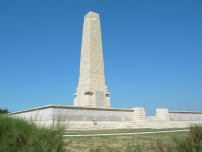| First Name: | James Arthur | Last Name: | BOWYER | |
|---|---|---|---|---|
| Date of Death: | 26/04/1915 | Lived/Born In: | Highbury | |
| Rank: | Corporal | Unit: | Royal Munster Fusiliers1 | |
| Memorial Site: | Helles Memorial, Gallipoli | |||
Current Information:Born-Aldershot Enlisted-London
Gallipoli 1915 On 25 April, 1915, British, Australian and New Zealand forces landed on the Gallipoli peninsula. The plan was that these forces would soon defeat a demoralised Turkish army, knock Turkey out of the war, open up the Mediterranean to the Russian navy and threaten Austro-Hungary from the south.None of these things were achieved despite nine months of hard fighting in terrible conditions. It was a heroic failure. The 29th Division and the Royal Naval Division landed at five separate beaches around Cape Helles. Some were not defended, others were fiercely contested. Some ground was gained but within days the familiar pattern of trench warfare had set in. A similar pattern emerged further north where the ANZACS landed. The Turkish soldiers were much tougher fighters than had been given credit for and they were of course fighting an invasion of their homeland. The terrain, a series of steep rocky ridges and deep gullies made the fighting much more difficult and during the hot summer of 1915, the flies arrived in biblical proportions. Another seven British divisions were sent to Gallipoli during the summer but little or no progress was made. In the end, a new Commander was appointed and plans to evacuate the entire force were drawn up. By January 1916, all British, Australian and New Zealand forces had left Gallipoli, leaving only behind the dead, over 56,000 of them. On 25th April, 1915, the 1st Royal Munster Fusiliers of 86 Brigade, 29th Division, landed at “V” Beach along with 1st Royal Dublin Fusiliers and 2nd Hampshire. Three of their companies were brought to the shore in landing boats towed by motor launches and the other embarked from the converted collier SS River Clyde which was beached. The Turks were ready and poured machine gun and rifle fire into the crowded boats as they made for shore and into the men as they tried to get off the River Clyde. It was a scene of pure carnage. Pilots circling overhead reported that the sea turned red from blood. Amazingly, enough soldiers from all three battalions managed to get ashore and return fire and eventually they established a small beach head onto which others could land. The following day, 26th April, the survivors of 1st Royal Munster Fusiliers attacked the Turkish positions, driving them out of Sedd el Bahr village and capturing Hill 141. James Bowyerwas killed in the fighting on this day. |
||||
| « Back to Search Results | ||||
| If you think any of the information shown here is incorrect, Click Here to submit your amends and comments | ||||




